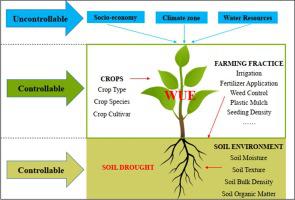Journal of Hydrology ( IF 5.9 ) Pub Date : 2021-01-12 , DOI: 10.1016/j.jhydrol.2021.125977 Liuyang Yu , Xining Zhao , Xiaodong Gao , Ruhao Jia , Menghao Yang , Xiaolin Yang , Yong Wu , Kadambot H.M Siddique

|
Agriculture’s need to feed the growing population is challenged by the decline in available water resources especially in the context of global climate change. Improving crop water use efficiency (WUE) will help to safeguard the environmental sustainability of food production in dryland areas. However, the impact of drought on crop WUE varies—a comprehensive and quantitative understanding of relevant factors is needed to support evidence-based management decisions. Here, we used a meta-analysis of global drylands (81 studies with 836 paired observations) to evaluate the response of various crop WUEs to drought based on various natural and human induced factors. Our results showed that responses of crop types’ WUE varied under drought intensity, which probably a reference for crop selection in drylands. Cotton could be one of crop selection reference in hyper-arid or arid regions, and legume is not recommended for drylands without irrigation. Cereal crop are suitable for growing in semi-arid or dry sub-humid areas. Moreover, soil improvement and fertilizer management are the effective methods to alleviate drought stress, in addition to irrigation. Soil with medium-texture, 1.3–1.4 g cm−3 bulk density and 15–20 g kg−1 organic matter is beneficial for improving WUE under drought. Fertilizer should be carefully considered and not exceed 200 kg ha−1 for wheat in drylands. Water deficit can improve crop WUE, but should not exceed 40% of the full irrigation amount. Field management practices, such as mulching and weed control, can help alleviate drought by regulating WUE to some extent. This study evaluated the responses of various crop WUEs to drought and highlighted the factors contributing to and/or decreasing crop WUE from natural factor and management practices, which provides a basis for agricultural drought mitigation strategies under future climate change in dryland areas.
中文翻译:

自然因素和管理措施对干旱条件下农业用水效率的影响:全球旱地的荟萃分析
可用水资源的减少,尤其是在全球气候变化的背景下,农业需要养活不断增长的人口。提高作物用水效率(WUE)将有助于保障干旱地区粮食生产的环境可持续性。但是,干旱对作物水分利用效率的影响各不相同-需要对相关因素进行全面和定量的了解,以支持基于证据的管理决策。在这里,我们使用了全球干旱地区的荟萃分析(81个研究与836个配对观测值),基于各种自然和人为因素评估了各种作物WUE对干旱的响应。我们的结果表明,作物类型的水分利用效率在干旱强度下变化,这可能是干旱地区作物选择的参考。棉花可能是高干旱或干旱地区的作物选择参考之一,不建议在没有灌溉的旱地使用豆类。谷物作物适合在半干旱或干燥半湿润地区种植。此外,除灌溉外,土壤改良和肥料管理是减轻干旱压力的有效方法。质地中等的土壤,1.3–1.4 g厘米−3的堆积密度和15–20 g kg -1的有机物有利于改善干旱条件下的水分利用效率。应仔细考虑肥料,在旱地小麦不超过200 kg ha -1。水分亏缺可以提高作物的水分利用效率,但不应超过总灌溉量的40%。覆盖和除草等田间管理措施可以通过在一定程度上调节WUE来帮助缓解干旱。这项研究评估了各种作物水分利用效率对干旱的响应,并强调了自然因素和管理实践对作物水分利用效率的影响和/或减少的因素,这为干旱地区未来气候变化下的农业减灾战略提供了基础。











































 京公网安备 11010802027423号
京公网安备 11010802027423号